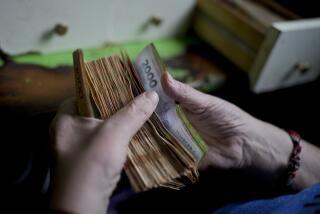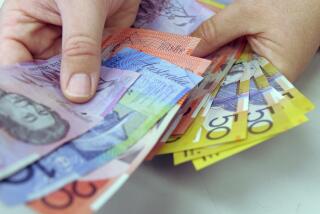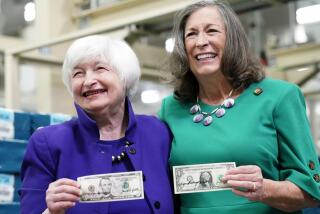Uneasy Money : U.S. Unveils $100 Note in Bid to Thwart Counterfeiters
WASHINGTON â In an elaborate ceremony that featured an actor playing Benjamin Franklin, the Treasury Department on Wednesday unveiled the newly designed $100 bill, revealing a stark look intended to foil high-technology counterfeiters.
The bills are the same size and color as existing greenbacks, but they feature a much larger portrait of Franklin, much less detailed scrollwork around the edges, a watermark embedded in the paper, ink that changes color when viewed from different angles and a security thread that will glow red under ultraviolet light.
Treasury officials said the changes are needed to address the rising threat posed by counterfeiters using advanced color scanners, personal computers and color ink-jet printers, which are enabling would-be counterfeiters to knock off passable fakes.
âWe are making our currency secure against the threat of advanced counterfeiting technology, so it will continue to be respected throughout the world as the store of value and symbol of security it has been for so long,â Treasury Secretary Robert E. Rubin said.
The redesign represents the most significant change to the greenback since 1929, when the current look and size was established to combat counterfeiting in that era. Although the new design marks a dramatic departure from the existing note, it was the most conservative of the various options that were examined, said Jack Ruther, the designer responsible for the new bill.
âAmerica isnât ready for radical changes,â Ruther said. âThe assignment was to change the currency but keep it looking American.â
New designs for the $50, $10, $5 and $1 bills, resembling the âarchitectureâ of the new $100 bill, will be introduced at the rate of one per year. Rubin, saying that counterfeiting is âde minimisâ as an economic problem, described the redesign effort as aimed at âstaying ahead of the curve.â
The unveiling was held inside the historic âcash roomâ at the Treasury Department, a grandiose salon where until the early 1970s, individuals could open savings accounts directly with the government.
A Secret Service color guard marched through the room and Benjamin Franklin was played by actor Dean Bennett, who quoted the statesman: âNothing but money is sweeter than honey.â The redesigned bill was cloaked by a black curtain that was raised by Rubin, prompting cheers from Treasury Department employees.
But Federal Reserve Board Chairman Alan Greenspan brought matters down to a more serious note, going to considerable lengths to explain that the older bills will still be accepted or will not be devalued in the future.
âAll existing notes will continue to be legal tender,â Greenspan said. âThe United States has never recalled its currency, and we are not doing so now.â
Treasury officials, however, acknowledged that people probably will not want the old bills once the new ones are available. As a result, the new bill is expected to quickly become common in the United States and abroad.
The Bureau of Printing and Engraving in Washington has already produced about $6.4 million worth of the new bills, but they will not begin circulating until early next year. Treasurer Mary Ellen Withrow, whose signature appears on the new note, said she wants to ensure a big supply to meet the demand of both regular commerce and the curios who will want the bills for the novelty.
The larger picture of Franklin is based on a portrait in the National Portrait Gallery that depicts the long-haired scientist and philosopher with a slight smirk. Thomas Hipschen, the engraver responsible for Franklinâs portrait on the new bill, began carving the image into a block of steel two years ago. Using tools that have changed little since the 1500s, Hipschen spent 500 hours on the work.
The larger portrait will be harder for counterfeiters to copy because it is more detailed and contains more fine lines than the portrait on the old bill.
The watermark will contain a small representation of Franklin, visible only when the bill is held up to the light. A color printer or copier cannot print the feature.
Although the existing $100 bill has a security thread, the new bill will have one that glows red when subjected to ultraviolet light. When redesigned smaller bills are introduced, their security threads will be in different places, allowing machines to more easily verify the denomination of the bills.
Among other, lesser changes, the new bill will contain a simplified Federal Reserve seal, deleting the name of the specific bank that issues the note. Microprinting that says âUSA100,â visible only with a magnifying glass, will be added to the lower left corner. And the color-shifting ink will appear on the lower right corner.
âIt still says, âIn God We Trust,â â Rubin said
(BEGIN TEXT OF INFOBOX / INFOGRAPHIC)
Benâs Face Lift
Ben Franklin is bigger, slightly left of center and maybe even a little more youthful on the new $100 bill unveiled Wednesday by the Treasury Department. The first overhaul of U.S. currency in nearly 70 years is part of an effort to thwart increasingly sophisticated counterfeiters. Here are some of the billâs features.
Security thread
This polymer thread is embedded in the paper and will glow red when held under an ultraviolet light.
Microprinting
âUSA 100â is microprinted within the number in the lower left corner, while âUnited States of Americaâ appears on Franklinâs lapel. The tiny words are extremely hard for counterfeiters to reproduce without blurring.
Larger portrait
Franklinâs portrait is 50% bigger to make it easier to recognize, while the added detail in the design makes it harder to duplicate.
Concentric fine-line printing
This series of lines in the portrait background is very difficult to reproduce.
Color-shifting Ink
The ink used to print the number in the lower right corner changes color from green to black when viewed from different angles.
Watermark
A second portrait of Franklin is only visible when held up to a light source. It does not reproduce on color copiers or computer scanners.
Sources: Associated Press, Treasury Department
More to Read
Sign up for Essential California
The most important California stories and recommendations in your inbox every morning.
You may occasionally receive promotional content from the Los Angeles Times.











